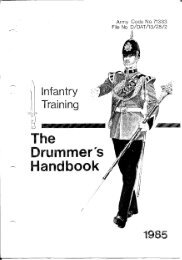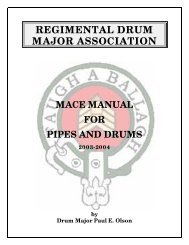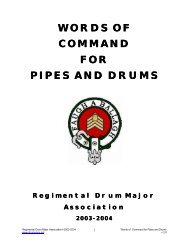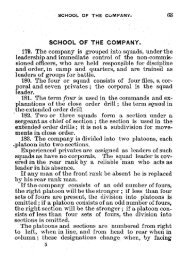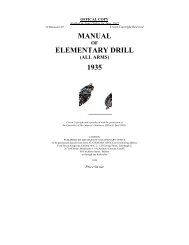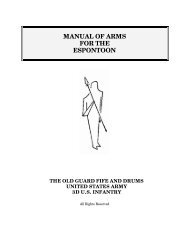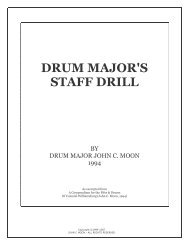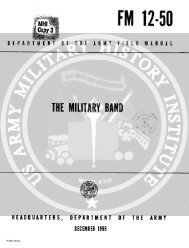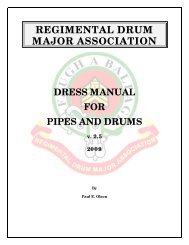Marine corps drill and ceremonies manual - Regimental Drum Major ...
Marine corps drill and ceremonies manual - Regimental Drum Major ...
Marine corps drill and ceremonies manual - Regimental Drum Major ...
You also want an ePaper? Increase the reach of your titles
YUMPU automatically turns print PDFs into web optimized ePapers that Google loves.
19-1. GENERAL<br />
CHAPTER 19<br />
FUNERALS<br />
a. When not contrary to orders <strong>and</strong> regulations, the extent to which<br />
the naval service participates in a funeral depends upon the expressed<br />
wishes of the family of the deceased.<br />
b. The composition <strong>and</strong> strength of the escort will be as prescribed<br />
in U.S. Navy Regulations or as modified by proper authority.<br />
c. The military aspect of a funeral usually begins at one of the<br />
following places: home of the deceased, mortuary, railroad station,<br />
church or chapel, cemetery gates, or the grave. It may, however, begin at<br />
any designated place.<br />
d. The ceremony starts when the remains are first received by the<br />
escort. Before that, the body bearers may be detailed to conduct the<br />
remains wherever necessary.<br />
e. In general, the escort receives the body at one of the following<br />
places:<br />
(1) The designated place <strong>and</strong> conducts it to the place of services<br />
<strong>and</strong> then to the grave.<br />
(2) The chapel before, <strong>and</strong> conducts it to the grave after, the<br />
services.<br />
(3) The cemetery gates <strong>and</strong> conducts it to the grave.<br />
(4) The grave.<br />
f. Each time the body bearers remove the remains:<br />
(1) The escort is brought to present arms.<br />
(2) The b<strong>and</strong> renders prescribed honors, followed by appropriate<br />
music.<br />
(3) The pallbearers salute.<br />
(4) All observers in uniform, except the body bearers, salute.<br />
(5) All civilian-dressed naval personnel, except women, uncover<br />
<strong>and</strong> hold the headdress over the heart with the right h<strong>and</strong>.<br />
Women place the right h<strong>and</strong> over the heart without uncovering.<br />
g. When the national color is draped on the casket, it shall be<br />
placed so the stars are at the head of the casket over the left shoulder<br />
of the deceased. Nothing shall rest on top of the national color. The<br />
color will be removed as the casket is being lowered into the grave, <strong>and</strong><br />
in time so the color will not touch the ground.<br />
h. The casket is always carried foot first, except in the case of a<br />
clergyman whose casket is carried into <strong>and</strong> cut of the church or chapel<br />
head first.<br />
i. Pallbearers may walk or ride, depending upon the distance to be<br />
covered.<br />
j. The senior pallbearer will give necessary cautionary comm<strong>and</strong>s to<br />
the others in a low voice. All salute at the comm<strong>and</strong> PRESENT, ARMS, when<br />
given by the escort comm<strong>and</strong>er.<br />
k. The personal flag of a deceased general or flag officer will be<br />
carried immediately in front of the hearse or caisson. If he was a unit<br />
comm<strong>and</strong>er or ship’s captain, the comm<strong>and</strong> or commission pennant will also<br />
be carried.<br />
19-1



